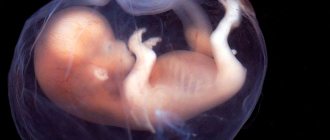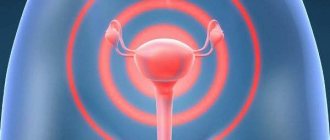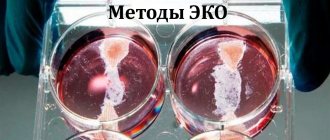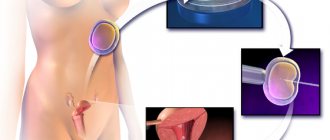Transfer of embryos into the uterine cavity is the final stage of the IVF procedure, which is carried out 3-5 days after fertilization of oocytes by sperm in the laboratory. The period of implantation of the fertilized egg into the endometrium depends on many factors: the quality of the embryos, the readiness of the uterus for conception and the woman’s health, etc. The success of the gestational planning cycle is often chalked up to “luck.” But in reality, the success of the procedure largely depends on the patient’s compliance with medical recommendations.
A little theory
Introduction of fertilized egg into the uterus
called implantation. The embryonic villi penetrate the lining of the uterus, which may cause minor bleeding.
In order for implantation to be successful, several conditions must be met:
- lush three-layer endometrium with a high content of substances that nourish the embryo;
- high amount of progesterone in the body (so that the embryo can develop and menstruation does not begin);
- normal microflora in the body.
The process of fertilization and development of the fertilized egg is not a one-step process. And each stage is important for the onset of a normal pregnancy and the formation of a healthy fetus.
Doctor's recommendations
To increase the chances of embryo implantation into the uterine wall, you should:
- during the first 24 hours after IVF, refrain from taking a bath or shower;
- avoid heavy lifting and emotional overload;
- maintain sexual rest for 10-14 days before receiving the results of the hCG test;
- exclude foods that cause flatulence from the diet;
- refuse to wear tight clothes (tight jeans, trousers);
- take daily half-hour walks in the fresh air.
It is advisable to spend the first days after the IVF procedure at home, alternating walks with rest. Doctors recommend taking fortified dietary supplements to maintain normal metabolism in the body.
The first days after the transfer of prepared blastomeres into the uterine cavity are the most critical, since during this period implantation of the fertilized egg into the endometrium is observed. The process of implantation of the blastocyst into the uterine wall occurs within a few days after the IVF procedure. The implantation itself takes no more than 40 hours, during which patients may feel heaviness in the lower abdomen, dizziness and increased tone of the uterus.
Any questions? We are happy to answer them Ask us a question Make an appointment
Ultrasound examination (ultrasound) after in vitro fertilization (IVF) differs significantly from other forms of examination. The most important thing is that ultrasound is prescribed more often, and it is carried out earlier than with traditional fertilization. The main task of such an examination is to confirm the fact of successful fertilization, as well as the normal course of pregnancy.
What you need to know about IVF
IVF involves the fertilization of an egg not in the woman’s body, but outside it. IVF is a unique method of treating infertility, as well as the only chance for those who want to give birth to a healthy baby.
The procedure is carried out only for strict indications: various types of infertility in women, as well as the inability to have children in men and women.
Remember! A woman should know that IVF is a very complex procedure, and ultrasound after it is carried out especially carefully. This is due to a clear and complex pattern of fertilization.
- First, the patient receives hormonal medications for follicle growth. It is necessary that as many eggs as possible mature in the body.
- The egg is extracted from the follicles using a very thin needle and an ultrasound probe.
- Sperm are obtained from seminal fluid. If it is impossible to obtain ejaculate, they are extracted from the testicles or previously frozen sperm is used.
- Laboratory selection of germ cells takes place.
- Next, the egg matures in the incubator and fertilization occurs.
- After a few days, the fertilized egg is transferred to the uterus. The patient again receives hormonal therapy to successfully implant the embryo in the uterine cavity.
IVF procedure
At what stage of embryo implantation and on what day is ultrasound performed?
The first ultrasound after extracorporeal research is done to ensure the success of embryo transfer. The date of the first ultrasound examination is selected based on the following dates:
- Usually 3 – 5 days the embryo is grown;
- implantation occurs on days 7–10;
- on the fourteenth day after the procedure, the level of human chorionic gonadotropin in the blood, the main hormone indicating the onset of pregnancy, is measured.
Thus, the first ultrasound examination is done later - 21 days. There is no definite point of view among doctors on the optimal timing of the first ultrasound. Most gynecologists advise having your first ultrasound approximately three weeks after the procedure or a little later. In any case, the procedure is prescribed when tests show an increased level of human chorionic gonadotropin in the blood, which confirms pregnancy. Sometimes the procedure is done on day 24.
Starting from the 20th day after embryonic transfer, the doctor performs an ultrasound, which makes it possible to examine the fertilized egg in full.
In some diagnostic centers and clinics, the first ultrasound examination is prescribed even later - around the sixth week. At this time, you can clearly see the fetus and hear its heartbeat.
The further schedule of ultrasound examinations is carried out according to the usual scheme: · for 11 – 14 weeks; · for 18 – 21 weeks; · for 30 – 32 weeks.
However, this is the most general graph. Sometimes the gynecologist can change it slightly and prescribe a second ultrasound two weeks after the first. In the future, ultrasound examinations may be required at the specified frequency or even more often.
Signs of pregnancy after in vitro fertilization
After embryo transfer, it usually takes three days for the cell to successfully implant. In some cases it takes up to ten days for this to happen. Late implantation is also considered normal.
Thanks to successful embryo implantation, the patient experiences the following first signs of pregnancy:
- toxicosis of pregnant women;
- redness of the skin;
- tides;
- an increase in temperature, indicating that the woman’s body is preparing to bear a child;
- sudden mood swings;
- swelling of the mammary glands;
- change in nipple shade.
Important! Sometimes artificial insemination may not cause these first signs of pregnancy. In this case, the completed embryo transfer is indicated by an increased concentration of human chorionic gonadotropin in the blood.
First ultrasound after embryo transfer
A woman does not need to worry that frequent ultrasounds will harm the baby. Such studies are absolutely safe for mother and child. So you can safely conduct such studies as prescribed by your doctor.
The technique of ultrasound examination during IVF is no different from that performed during conventional fertilization. A doctor may use one of two types of ultrasound diagnostics.
1. Transabdominal (external) examination (scanning). It is carried out through the anterior abdominal wall. This uses an ultrasonic sensor that emits and receives high-frequency sound waves. Ultrasound and the sensor do not cause any discomfort to the expectant mother. This option is most successful for the second or third trimester, when the fetus is already quite large.
2. Transvaginal examination. In this case, the ultrasound sensor is inserted directly into the vagina. It is recommended to carry out this procedure in the early stages of pregnancy. After all, the embryo in this period is very small in size, and it is very difficult to see it using the usual method.
In addition, with this method of examination, the cervix can be examined in detail.
For the patient, this procedure is very simple and does not cause inconvenience. There is no need to follow a special diet. Before the examination, you must empty your bladder and bowels. It is also necessary to limit the consumption of foods that contribute to the formation of gases in the intestines.
For the first ultrasound, only transvaginal examination is used. This is due to the fact that the doctor must examine the embryo in detail, as well as its location. This method of research is extremely important for increasing the accuracy of diagnosis. Subsequently, the doctor can repeat the transvaginal examination, and in the future - do only the transabdominal one.
What does such research show and why is it done?
Take note! In vitro fertilization does not provide a complete guarantee. It takes several attempts for pregnancy to occur. However, sometimes just one transfer is enough for a successful pregnancy.
Statistics show that embryo transfer is successful in 40 to 60 percent of cases. In a quarter of all cases, the development of multiple pregnancies is possible. And finally, in rare cases, an ectopic pregnancy may develop. This is why it is so important to do the first ultrasound after this type of fertilization.
In addition, the first ultrasound is done to ensure that the embryo resulting from IVF is viable.
The first ultrasound shows:
- the success of the embryo transfer (that is, the doctor can make sure that pregnancy has occurred);
- location of the fertilized egg (in the uterus, ovaries or egg tubes);
- the number of embryos obtained as a result of in vitro fertilization;
- viability of the embryo(s) after transfer;
- functionality of the ovaries (to clarify the need for hormonal correction).
The role and significance of the first ultrasound after in vitro fertilization is enormous. After all, this procedure is not just confirmation of implantation and successful transfer. Ultrasound can detect very dangerous pathologies at the earliest stages - for example, a frozen or ectopic pregnancy. Detecting multiple pregnancies as a result of IVF is also very important. Indeed, in this case, the doctor will prescribe a special regimen for the patient.
Further actions
A successful result of an ultrasound examination after embryo transfer is not a reason not to consult a doctor in the future for diagnostics. On the contrary, a woman should be extremely attentive to her body and promptly respond to any suspicious symptoms. That's why she needs to undergo repeated diagnostic tests. Most often, they are done using ultrasound - the safest way to see the vital functions of the body.
As a rule, a second ultrasound is performed on day 31 after embryo transfer. This must be done to determine the condition of the embryo and record its heartbeat. If the heartbeat recording gives a positive result, the woman is registered with an obstetrician. He monitors the patient throughout the entire pregnancy and, if necessary, conducts repeated studies.
If the results of the extracorporeal study are unsatisfactory, the procedure is repeated. However, this can be done no earlier than three months later. If embryos were cryopreserved after the first attempt, then there is no need to repeat stimulation in the future. In this case, IVF can be performed more often.
conclusions
Ultrasound after in vitro fertilization is the most important diagnostic procedure. It allows you to determine the effectiveness of the procedure and decide on further actions. A woman does not have to worry that ultrasound will harm the unborn baby: it is absolutely harmless to him. A woman should also adhere to the established schedule for ultrasound procedures. This way, it will be possible to promptly determine the pathology of pregnancy and prescribe timely treatment.
Timing of implantation
After ovulation and the meeting of the egg with the sperm, the fertilized zygote begins to move through the fallopian tubes. Its task is to get into the uterus as quickly as possible in order to gain a foothold in the endometrium specially prepared for this. Along the way, the zygote continuously divides and grows. occurs at the blastocyte
Conventionally, we can distinguish between middle, late and early implantation.
- Early. It is quite rare. Usually, implantation that occurs 6-7 days after ovulation is considered early (or 3 dpp - 4 dpp if we are talking about IVF)
- Average. 7-10 days pass between fertilization and implantation ( implantation of the embryo after transfer occurs approximately 4-5 days). Doctors say that it takes about 40 hours for morula to penetrate, after which the body begins to produce the hormone hCG in the blood, and the basal temperature . Based on this, the so-called embryonic period of development, which lasts until approximately 8 weeks of pregnancy.
- Late. Occurs approximately 10 days after fertilization. This is what always gives women at least a faint hope of a possible pregnancy - even when you can hardly expect it anymore.
If pregnancy does not occur for a long time, then you need to be examined to identify the cause of infertility.
What should you be wary of?
After IVF treatment, a woman needs to closely monitor her well-being. Unusual symptoms or signs that cause discomfort should be cause for concern. If you have any doubts about your feelings, it is better to consult your doctor once again. If necessary, the doctor will conduct an additional examination to understand the causes of concern.
In case of failure, menstruation after embryo transfer is expected within 2 weeks. If bleeding started earlier, this may indicate a pathology. When transplanting cells, the mucous membranes of the cervical canal, cervix or vagina may be damaged. Therefore, prolonged spotting or heavy bleeding is not normal. Other abnormalities can also cause this symptom: ovarian apoplexy, polyp, endometriosis.
Copious discharge after replanting, which is accompanied by an unpleasant odor, indicates an infection. Green and yellow ones occur with bacterial vaginosis, and white and curdled ones become a sign of thrush. Treatment methods are selected in accordance with the cause that caused the symptom.
Brown discharge that begins 2 weeks after cell transfer may indicate failure and the onset of menstruation.
Acute pain
If there is a strong pull in the lower abdomen after embryo transfer, this may also be a sign of an inflammatory process in the uterus or appendages. If you do not follow medical recommendations, the transferred cells can move from the cavity of the reproductive organ, for example, into the fallopian tubes. The consequence will be an ectopic pregnancy.
Acute pain in the lower abdomen after the transfer cannot be ignored. They may turn out to be ordinary intestinal colic, but this must be confirmed by a specialist.
Heat
Body temperature after embryo transfer should not exceed 37.5 degrees. If a woman develops hyperthermia, this indicates a complication of the medical procedure. The causes of this condition can be various pathologies: infection, ovarian cyst, inflammation of the vagina or uterus.
Colds often occur after embryo transfer, as immunity decreases in the early stages of pregnancy. This condition is accompanied by fever, runny nose and sore throat.
We trust nature
Women re-read tons of literature, trying to find those 5 dpo sensations
or
6 dpp sensations
that would indicate implantation and, accordingly, the onset of pregnancy.
Actually, expectant mothers start worrying whether it worked or not at 3 DPO
.
This question is equally of concern to girls who have undergone the IVF procedure. Estimated embryo implantation after IVF
They try to catch it by minimal changes in the body and well-being.
The Internet is replete with requests like “ 5 dpp of three days
”, “
4 dpp of five days”
, “
7 dpp of five days
”, with the help of which women look for positive stories.
The absence of even a hint of a second page on day 8
or
menstruation after embryo transfer
.
But in fact, the answer to the question of why the embryo does not take root
may be an objective situation of natural selection. The non-viable fetus was rejected, giving way to healthy offspring.
In fairness, it is worth noting that if such rejection is repeated constantly, then this is a reason for a full medical examination. The reason for the failure of a long-awaited pregnancy may be male infertility.
Implantation is a critical point, because the blastocyte is perceived by the woman’s body as a foreign object due to the presence of male genes in the cell. The speedy and successful introduction into the endometrium and the onset of a normal healthy pregnancy depend on how well the defense mechanisms of this cell work.
After the procedure of puncture of the female reproductive glands, 3-5 days pass and one of the most crucial moments begins - transfer (transfer) of the embryo to the uterus. Inserting a diploid cell into a woman’s body takes no more than 5-7 minutes, but the success of the IVF procedure will depend on the correctness of the manipulations performed, the quality of the blastomeres and the patient’s behavior.
How to behave after the transfer
Bed rest after the IVF procedure is not required.
A woman must follow all doctor’s instructions for taking medications and undergo prescribed examinations in a timely manner. In general, the lifestyle remains the same. It is advisable to spend more time in the fresh air, eat right, sleep 8 hours a day, and be less nervous and worried. It is advisable to observe sexual rest for the first 2 weeks after the transfer. According to your doctor's recommendations, you should exclude:
- heavy physical activity;
- staying in crowded places;
- wearing high-heeled shoes;
- sleep in a prone position.
To prevent bloating and gas formation, it is advisable to eat light foods - boiled meat or fish, cottage cheese, eggs, cereals. Walking, including long distances, is useful.
After embryo transfer, the woman is given individual recommendations. The main point is post-transfer support. All medications prescribed by the doctor must be taken. The patient should also reduce physical activity in the first few days. It is not at all necessary to lie down constantly after embryo transfer, but you should not engage in sports.
Features of in vitro fertilization
In vitro fertilization is a modern reproductive technology that is used for infertility. During the procedure, an oocyte is removed from the ovaries and fertilized under “in vitro” conditions. After this, the diploid cell is cultivated in a special incubator for 3-5 days.
The reproductive specialist decides at what point to transfer the embryo into the uterus, focusing on the degree of preparedness of the endometrium for implantation. It is believed that five-day-old embryos take root better, but not all fertilized oocytes can survive to transfer at the appointed time.
When will the IVF result be known?
The first ultrasound after embryo transfer is done no earlier than 2-3 weeks later. This study reliably confirms pregnancy if it is in the uterus. The test for home use will also show the result no earlier than after 14 days.
The earliest diagnosis that can show that IVF went well is a blood test. Human chorionic gonadotropin (hCG) can be detected in the body as early as day 2 after implantation. You need to donate blood 10-12 days after the transfer.
- Why does fainting occur?
- Why do my legs burn below the knees? Hot flashes in the feet Heat in the feet causes this disease.
HCG analysis - rules for delivery
The concentration of hormones in the body of the expectant mother is determined by collecting venous blood. Reproductologists recommend taking tests in the morning on an empty stomach - at least 8-9 hours should pass between the last meal and blood donation. If a woman is taking over-the-counter medications, she should tell her doctor a few days before the tests.
Enzyme immunoassay must be performed not only to determine gestation. The hCG test should also be taken in the 2nd trimester of pregnancy in order to identify defects in the development of the child. Correction of maintenance therapy can prevent up to 25% of congenital pathologies and anomalies.
Cryo protocol. The agonizing wait for hCG...
And then sit and wait, especially since I, like many of you, have nothing to worry about. Can anyone tell me how frozen embryos are transferred? Where did you get the idea that it didn’t work??? The doctor called me back! And she said about the same thing! And she also told me to drink some hemostatics! They make you happy and give you hope!!! I'll give it a go and write what happened! The doctor didn’t tell me how to behave; yesterday I was bending down to wash and rinse (((((It turns out I couldn’t bend over.
And the fact that 2 days is even good... they develop better inside us... Unfortunately, I have one fetus without a heartbeat, but I believe that the second one will be born healthy and strong!!! I’ll write about myself, maybe it will help someone answer the questions that are now in my head! They stimulated them with a very small dose and took 10 eggs, 6 of them mature. 4 were fertilized. Well done everyone) they planted 2 four-day-olds, and froze 2 five-day-olds.
Woman's feelings and well-being
From the tenth to the fourteenth day, the amount of human chorionic gonadotropin constantly increases. On the 11th, 12th or 13th day, a woman may feel the first real signs of pregnancy: an increase in the size of the mammary glands, mild nagging pain in the lower abdomen, morning sickness, a change in taste preferences. Sometimes there is a headache, slight weakness appears, dizziness, discomfort, and sleep disturbances are possible. These symptoms are often observed after embryo transfer, starting from day 10.
You can find out about pregnancy 2 weeks after the implantation. At this time, blood donation from a vein is prescribed to determine the concentration of hCG. If the result exceeds 25 mIU/ml, it makes sense to talk about a successful protocol. It is important to monitor hCG over time by donating blood again at 15, 16, 18 and 21 DPP. If there is no increase in the concentration of human chorionic gonadotropin, the doctor diagnoses a frozen pregnancy.
Is it possible to determine the presence of pregnancy in the early stages based on how you feel after embryo transfer? How to behave if there is severe pain, or, on the contrary, there is a complete absence of pregnancy symptoms?
Positive signs
Pregnancy can be determined by how you feel no earlier than 9 days after replantation. A woman experiences the same sensations as during natural conception.
Positive signs indicating a possible pregnancy:
- morning sickness or vomiting;
- slight dizziness;
- weakness, malaise, drowsiness;
- excessive irritability and frequent mood swings;
- breast enlargement by 1–2 sizes;
- increase in body temperature to 37.5 degrees;
- slight nagging pain in the lower abdomen;
- feeling of discomfort in the abdominal area.
The complete absence of pregnancy symptoms should not frighten or alarm you. Many patients, after a successful protocol, note that they did not notice any obvious signs of pregnancy. You shouldn’t set yourself up for an unfavorable outcome in advance. If you experience severe pain or excessive bleeding, you should immediately consult a doctor.
Status after unsuccessful transfer
Ovarian hyperstimulation is a common phenomenon that occurs after an IVF procedure. In order for the egg to mature and subsequently take root in the uterus, reproductive specialists in the IVF protocol prescribe the patient to stimulate ovulation with potent drugs.
During hyperstimulation, the patient experiences unpleasant sensations:
- bloating, feeling of fullness from the inside;
- heat;
- the appearance of shortness of breath, weakness;
- severe pain in the uterine area;
- nausea, often vomiting.
If you have such symptoms, you should immediately seek help from a fertility specialist. The doctor will prescribe therapy for the patient in a hospital setting.










